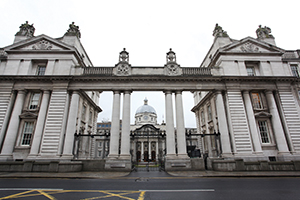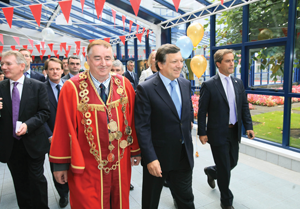Forming a government
A discussion of the potential avenues available in the creation of the next Government.

The election is over and all 158 seats have been filled but unlike 2011, the outcome from this election, in terms of the next Taoiseach and the next government is far from certain.
At the first sitting of the 32nd Dáil on 10 March Enda Kenny, Micheál Martin, Gerry Adams and Richard Boyd Barrett failed in their bids to become Taoiseach. In accordance with the Constitution this means that Kenny will continue to carry out the duties of the role until his successor is appointed.
There is no mention of time limits for agreement to be reached in the Constitution, so the caretaker government can continue for as long as the negotiations between the various parties do. However, the longer these talks continue the more the pressure on the parties to reach an agreement will grow.
The two largest parties in the Dail, Fine Gael and Fianna Fáil are now trying to find a way forward. The three most likely outcomes from these discussions are that either one of these parties will lead a minority government, there will be a grand coalition between the two or no agreement will be reached and a second election will be a necessity.
Option 1: Minority government
In this scenario either Fine Gael or Fianna Fáil would form the government themselves but would be reliant on other TDs supporting or not actively blocking the passing of legislation. If it was a Fine Gael minority government, the party would hold all the ministries itself and be alone at the cabinet table. This would leave it 30 deputies short of a majority and any legislation that is proposed could easily be voted down by the rest of the House.
This could potentially require Fine Gael to seek the support of Fianna Fáil who could decide, like every other party, to vote on a vote-by-vote basis to support the government or stand in its way. As this scenario relies on constant support from the opposition it is politically precarious as it gives other parties the ability to easily take down the government if they so desire. As such, despite Fine Gael holding power in this scenario, the party most likely to benefit from this arrangement would be Fianna Fáil as they would effectively have control of the timing of the next election.
As Micheál Martin’s party only have six fewer seats than Fine Gael the possibility remains that it could form a minority government. This scenario would again see the government forced to rely on the support of other parties and would also require Fine Gael agreeing to go into opposition.
Option 2: Grand coalition
The term grand coalition has rarely been used in Irish politics as it is usually used to define an agreement between two large parties diametrically opposed to each other governing together. However, the possibility of Fine Gael and Fianna Fáil entering government as partners is one option that would have the support of Labour, the Green Party and Sinn Féin but how would it work in practice?
As with any coalition, the working would be decided in discussion between the two parties. As well as merging policies to form a Programme for Government, they would also have to agree on how the ministries are distributed and which party would have the most. In discussions of this nature the larger party is usually able to get what it wants but because the two parties in this discussion are so close in terms of seat numbers, it is unlikely that negotiations will be easy. While there are some in Fianna Fáil who support the idea there remains strong opposition to it from many party members who remain unsure about handing the position of leader of the opposition to Sinn Féin. Before any decision on power sharing could be taken, the matter would have to be put before a Fianna Fáil Ard Fheis.
 There have even been suggestions of a rotating Taoiseach option between Enda Kenny and Micheál Matin each holding the position for an agreed period. While such an agreement may seem unlikely it cannot be ruled out. It is also worth remembering that in 1989 Fianna Fáil leader Charles Haughey ruled out a coalition government only to change his mind nine days later and enter into power with the Progressive Democrats.
There have even been suggestions of a rotating Taoiseach option between Enda Kenny and Micheál Matin each holding the position for an agreed period. While such an agreement may seem unlikely it cannot be ruled out. It is also worth remembering that in 1989 Fianna Fáil leader Charles Haughey ruled out a coalition government only to change his mind nine days later and enter into power with the Progressive Democrats.
Option 3: Another election
If no agreement can be reached as to who should govern, the general public will be asked to return to the ballot boxes and vote again in the hope that a different result can create an avenue for the creation of a stable government.
However, no matter what they say, politicians dread elections and the uncertainty it brings and very few TDs want to consider another campaign so soon. There is a sense amongst all parties that Fianna Fáil has the most to gain by going down this route as its unexpected success should help it raise funds easily. Labour have also kept some funds in reserve and there is hope in the party that such an election could allow them to regain some of the seats they recently lost as such an election would be difficult for Independents and other small parties to compete in.
Similarly, the question of government would likely hang over this election and the suggestion that Fine Gael and Fianna Fáil would not do business with each is unlikely to play well with weary voters asked to return to the ballot box again.
Evidently, there are many potential options for a new government to be formed. While many expected the real talking between the parties would only take place after the first sitting of the Dáil, the decision by Enda Kenny to call for its to return on the 22 March shows his desire to form a government soon. Ultimately, the future of Ireland’s next government remains unclear but one thing is for certain the majority of parties and the majority of Independent TDs do not want another election called anytime soon.

